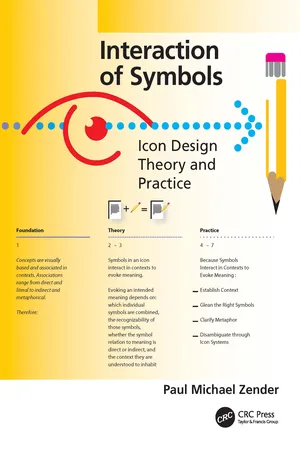
- 350 pages
- English
- ePUB (mobile friendly)
- Available on iOS & Android
About this book
Interaction of Symbols is a book for everyone engaged with icon design. It presents a theory of how icons work: symbols in an icon interact to evoke meaning. From this theory flow design principles and practices based on evidence from Design and other disciplines such as Psychology, Perception, and Cognition. The theory, principles, and practices impact how all symbol-based communications are conceived, designed, and applied.
The book focuses on icons that elicit a concept without any previous training or use of language. Findings from twenty years' worth of empirical design research studies explore, illustrate, and support each principle, process, and recommendation. The book begins with a review of icon research from various fields before laying a conceptual foundation that grounds the theory of the book. After and elaborating on that theory are chapters that demonstrate how to Establish Contexts to Guide Comprehension, Glean Which Symbols to Draw, Learn How to Draw Understandable Symbols, Clarify Metaphor, and Use Icons to Decipher Icons in Icon Systems. Written and carefully designed for a broad audience, the book's scholarly level is elevated while the presentation is approachable. Scholar or professional can skim, scan, or dig, it's up to them.
Heavily illustrated and supported with ample citations, it is not only a book for students and professionals within the field of communication design, but also for anyone who communicates with visual symbols, from healthcare professionals to software engineers, affecting all kinds of graphic communications from advertisements to assembly instructions.
Frequently asked questions
- Essential is ideal for learners and professionals who enjoy exploring a wide range of subjects. Access the Essential Library with 800,000+ trusted titles and best-sellers across business, personal growth, and the humanities. Includes unlimited reading time and Standard Read Aloud voice.
- Complete: Perfect for advanced learners and researchers needing full, unrestricted access. Unlock 1.4M+ books across hundreds of subjects, including academic and specialized titles. The Complete Plan also includes advanced features like Premium Read Aloud and Research Assistant.
Please note we cannot support devices running on iOS 13 and Android 7 or earlier. Learn more about using the app.
Information
Table of contents
- Cover Page
- Half-Title Page
- Title Page
- Copyright Page
- Contents
- Introduction
- 1. Icons Are Useful, Ubiquitous, and Misunderstood
- 2. Evoke Meaning through Interaction of Symbols
- 3. Establish Context to Guide Comprehension
- 4. Glean What to Draw: Choosing Symbols for Multi-Symbol Icons
- 5. Learn How to Draw It: Drawing Symbols People Will Understand
- 6. Clarify Metaphor: Informing People of Indirect Symbol Meaning
- 7. Disambiguate through Icon Systems: Using Icons to Decipher Icons
- 8. Historic Validation & Final Recommendations
- Appendix
- Index
- Dedication Page